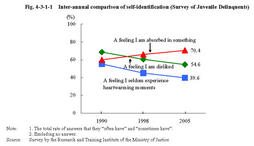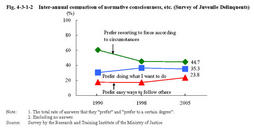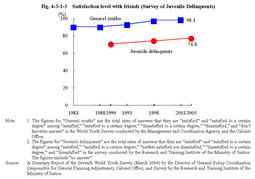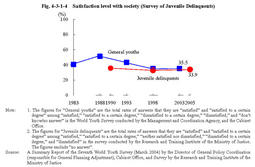| Previous Next Index Image Index Year Selection | |
|
|
1 Changes in attitudes of juvenile delinquents The"Survey of Juvenile Delinquents"covers those put under protective detention for juveniles in juvenile classification homes nationwide for two months from February14to April15,2005,totaling2,897(2,552males(88.1%)and345females(11.9%)).The average age was16.9years old.
The Research and Training Institute of the Ministry of Justice also conducted"Surveys of Juvenile Delinquents"in1990and1998.We will examine the changes in their attitudes by comparing the results of these surveys and the current survey. (1) Self-identification Fig.4-3-1-1 shows an inter-annual comparison of answers to major questions concerning self-identification.
The rate of answers that they"have"(the total of"often have"and"sometimes have";hereinafter the same)"a feeling I am disliked"(a question related to a negative self-image)and that they have"a feeling I seldom experience heartwarming moments"(a question related to alienation)has decreased,while the rate of answers that they have"a feeling I am absorbed in something"has been on a rise.This result indicates that self-identification of juvenile delinquents is changing to be positive. Fig.4-3-1-1 Inter-annual comparison of self-identification(Survey of Juvenile Delinquents) (2) Normative consciousness,etc. Fig.4-3-1-2 shows an inter-annual comparison of answers to major questions concerning normative consciousness and social attitudes.
The rate of answers that they"prefer"(the total of"prefer"and"prefer to a certain degree";hereinafter the same)"resorting to force according to circumstances"showed a declining trend,while the rate of answers that they prefer"doing what I want to do"and that they prefer"easy ways to follow others"has increased.Although a self-centered tendency to prioritize what they want to do has become more prominent,forceful attitudes to insist on self-assertiveness even through using physical force are not observed and it is also suggested that a tendency to prefer an easy position to avoid responsibility has become stronger. Fig.4-3-1-2 Inter-annual comparison of normative consciousness,etc.(Survey of Juvenile Delinquents) (3) Satisfaction level with friends and society We compare the results of the"Survey of Juvenile Delinquents"with those of the World Youth Survey conducted by the Management and Coordination Agency,and the Cabinet Office.
As the World Youth Survey,covering males and females aged18-24(hereinafter referred to as"general youths"in this Chapter),was conducted in a different year,an accurate comparison is difficult.However,comparison would be meaningful to generally understand the differences in attitudes between general youths and juvenile delinquents. Fig.4-3-1-3 shows a comparison between juvenile delinquents and general youths on their satisfaction level with friends. For both juvenile delinquents and general youths,the satisfaction level with friends has been on a rise year by year,but the rate of juvenile delinquents who are"satisfied"(the total of"satisfied"and"satisfied to a certain degree";hereinafter the same)with friends has been around20points lower than that of general youths.The level of satisfaction with friends is apt to be lower for juvenile delinquents than for general youths. Fig.4-3-1-3 Satisfaction level with friends(Survey of Juvenile Delinquents) Fig.4-3-1-4 shows a comparison between juvenile delinquents and general youths on their satisfaction level with society.The rate of feeling"satisfied"with society was similarly low for both juvenile delinquents and general youths. Fig.4-3-1-4 Satisfaction level with society(Survey of Juvenile Delinquents) |



